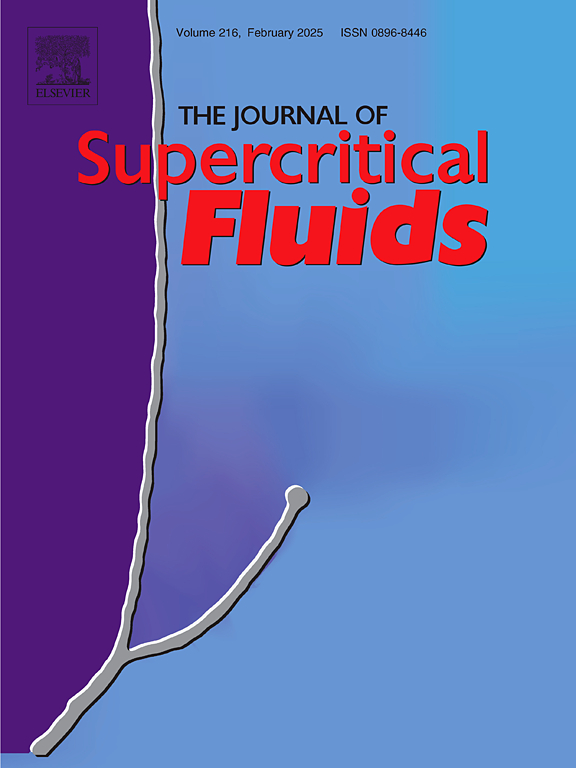Modelling and optimization of supercritical CO2 drying of tuna (Thunnus albacares) fillets: Unraveling physicochemical and structural changes
IF 3.4
3区 工程技术
Q2 CHEMISTRY, PHYSICAL
引用次数: 0
Abstract
This study explores and optimises the innovative supercritical carbon dioxide (SC-CO2) drying process for tuna fillets (Thunnnus albacares), offering a sustainable alternative for food preservation. Using a central composite rotatable design (CCRD), we assessed the effect of drying time (120–360 min), temperature (35–45°C), and flow rate (15–25 kg/h) at 10 MPa on key quality attributes: moisture content, water activity (aw), rehydration capacity (RC), pH, and total colour difference (ΔE). Our findings indicated that drying time and CO2 flow rate are the main factors affecting the water content. Drying time and flow rate significantly reduced moisture content and aw, while RC improved with prolonged time and higher flow rates. Despite increases in pH (from 6.01 to 6.405) and ΔE (23.51) due to the treatment, these changes did not compromise the product’s overall quality. Optimal drying parameters were determined as 377.2 min, 39.7 °C, and 27.3 kg/h, with subsequent confirmatory experiments using three different conditions validating the moisture model. However, spectroscopy and microscopy analyses indicated potential lipid and protein oxidation related to the CO2 flow rate, highlighting avenues for future research to refine this promising drying technique.
金枪鱼鱼片超临界CO2干燥的建模和优化:揭示理化和结构变化
本研究探索并优化了创新的超临界二氧化碳(SC-CO2)干燥金枪鱼片(Thunnnus albacares)工艺,为食品保存提供了可持续的选择。使用中心复合旋转设计(CCRD),我们评估了干燥时间(120-360 min)、温度(35-45°C)和流量(15-25 kg/h)在10 MPa下对关键品质属性的影响:水分含量、水活度(aw)、再水合能力(RC)、pH值和总色差(ΔE)。结果表明,干燥时间和CO2流量是影响水分含量的主要因素。干燥时间和流量显著降低了含水率和aw,而RC随着干燥时间的延长和流量的增大而提高。尽管由于处理,pH值(从6.01到6.405)和ΔE(23.51)有所增加,但这些变化并未影响产品的整体质量。确定最佳干燥参数为377.2 min、39.7°C和27.3 kg/h,并在随后的三种不同条件下进行验证实验,验证水分模型。然而,光谱学和显微镜分析表明,潜在的脂质和蛋白质氧化与二氧化碳流速有关,这突出了未来研究改进这种有前途的干燥技术的途径。
本文章由计算机程序翻译,如有差异,请以英文原文为准。
求助全文
约1分钟内获得全文
求助全文
来源期刊

Journal of Supercritical Fluids
工程技术-工程:化工
CiteScore
7.60
自引率
10.30%
发文量
236
审稿时长
56 days
期刊介绍:
The Journal of Supercritical Fluids is an international journal devoted to the fundamental and applied aspects of supercritical fluids and processes. Its aim is to provide a focused platform for academic and industrial researchers to report their findings and to have ready access to the advances in this rapidly growing field. Its coverage is multidisciplinary and includes both basic and applied topics.
Thermodynamics and phase equilibria, reaction kinetics and rate processes, thermal and transport properties, and all topics related to processing such as separations (extraction, fractionation, purification, chromatography) nucleation and impregnation are within the scope. Accounts of specific engineering applications such as those encountered in food, fuel, natural products, minerals, pharmaceuticals and polymer industries are included. Topics related to high pressure equipment design, analytical techniques, sensors, and process control methodologies are also within the scope of the journal.
 求助内容:
求助内容: 应助结果提醒方式:
应助结果提醒方式:


